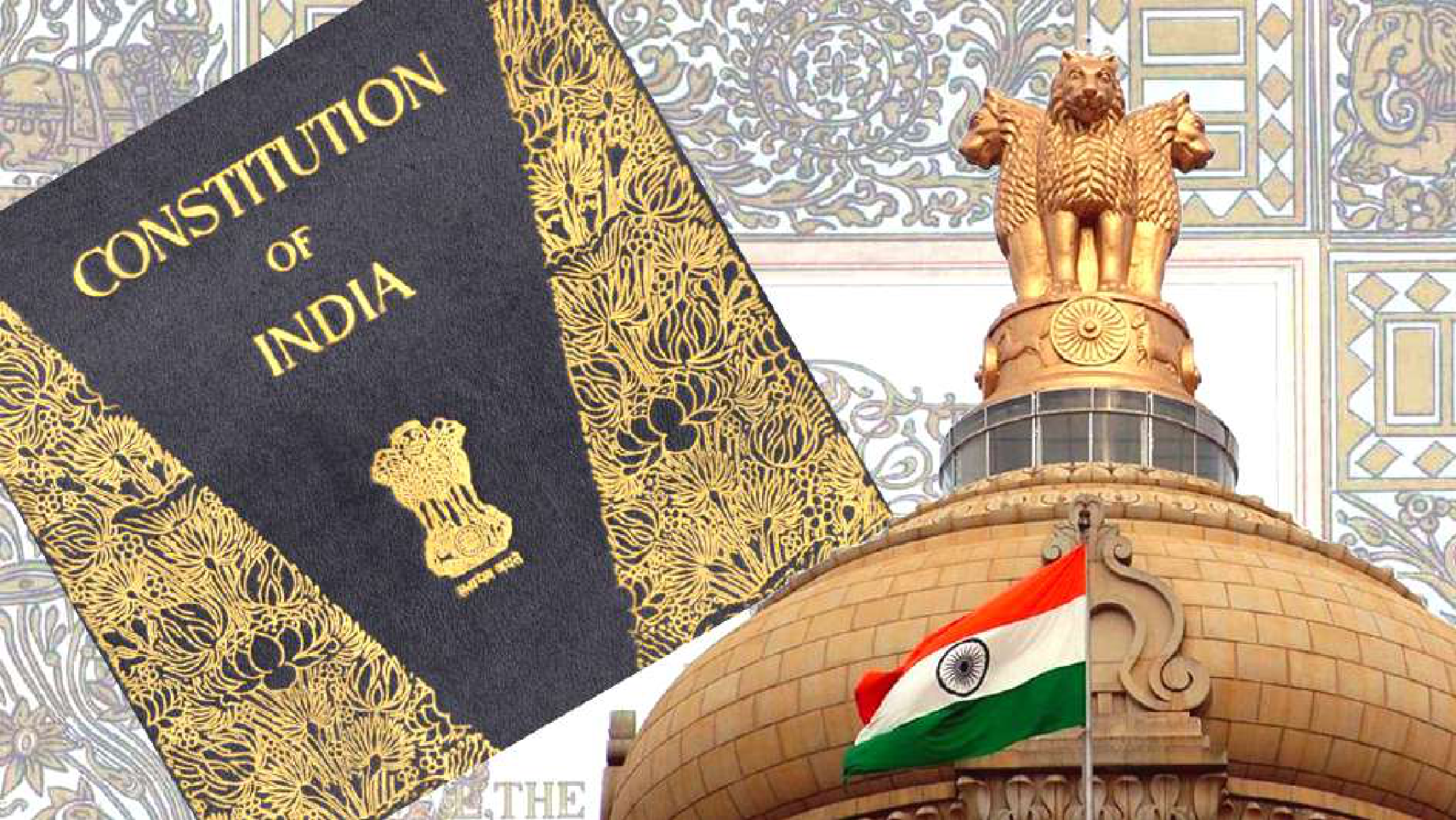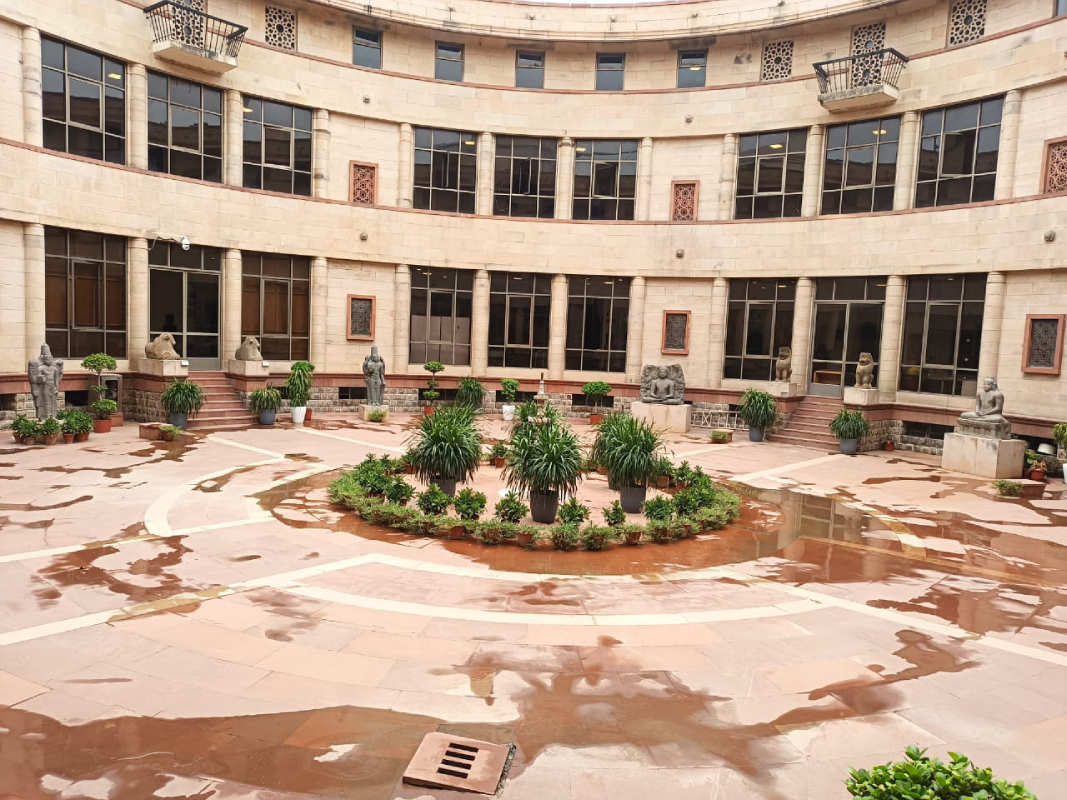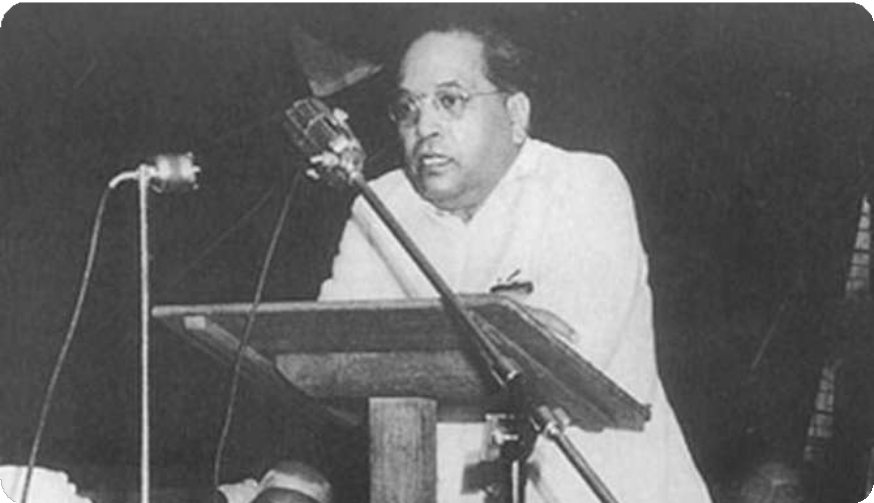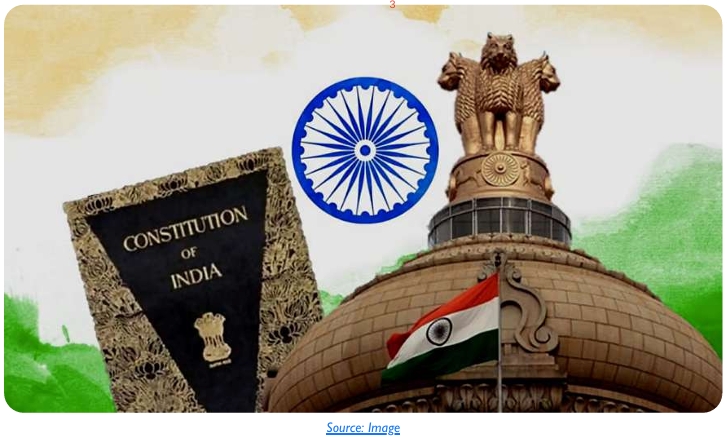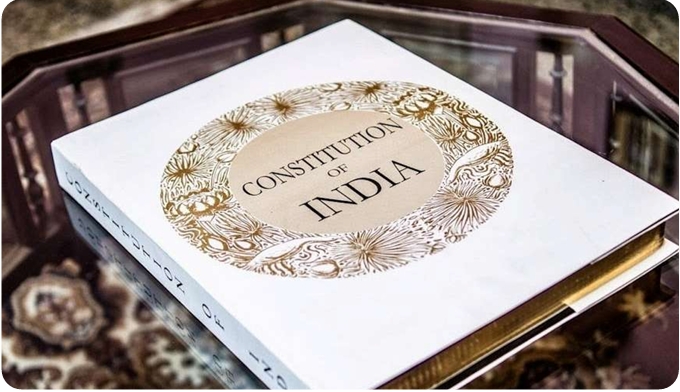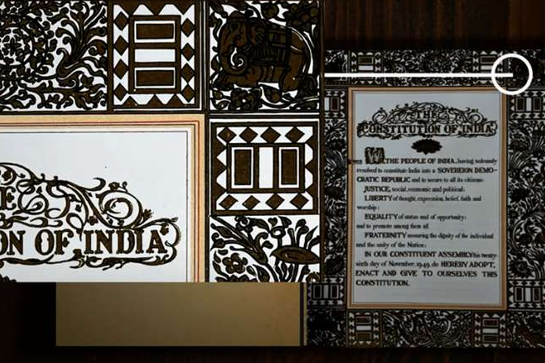“[While] A great judgment restores the constitutional values of a polity from the waywardness into which it may have fallen, a landmark judgment is one which opens up new directions in our constitutional thinking and, in the process, adds new dimensions to what are regarded as established constitutional principles. If “great” restores the centrality of constitutional values, “landmark” revitalises them.” Peter Ronald deSouza, Professor at the Centre the Study of Developing Societies, Delhi[1]
Landmark court decisions in India substantially change the interpretation of existing law. Such a landmark decision may settle the law in more than one way. In present-day common law legal systems, it may do so by:
- Establishing a significant new legal principle or concept:
- Overturning prior precedent based on its negative effects or flaws in its reasoning.
- Distinguishing a new principle that refines a prior principle, thus departing from prior practice without violating the rule of stare decisis;
- Establishing a “test” (that is, a measurable standard that can be applied by courts in future decisions).
In India, landmark court decisions come most frequently from the Supreme Court of India, which is the highest judicial body in India. High courts of India may also make such decisions, particularly if the Supreme Court chooses not to review the case or if it adopts the holding of the lower court.
Before we proceed further, we are tempted to refer to two observations by legal luminaries.[2] The first is on the organic element of law by Justice S. Ratnavel Pandian, that “[T]he inevitable truth is that law is not static and immutable but ever increasingly dynamic and grows with the ongoing passage of time”. The history of landmark judgments is a testimony to that. The other quotation is by former CJI, D.Y Chandrachud: “When histories of nations are written and critiqued, there are judicial decisions at the forefront of liberty. Yet others have to be consigned to the archives, reflective of what was, but should never have been.” The judgments we create here are testimony to both these observations.
Great Judgments
We begin by looking at four recent great judgments that could potentially impact large constituencies of the population and have restored the constitutional values of a polity from the waywardness into which it had fallen[3]:
Withdrawal of remission granted to Bilkis Bano convicts | Bilkis Yakub Rasool v Union of India | Two-judge bench
A judgement that quashed the Gujarat government’s order to release 11 convicts in the Bilkis Bano case was the first big decision to make headlines from the Supreme Court in 2024. The convicts were sentenced for life for the gang rape and murder of Bano’s family during the 2002 Gujarat Riots. It was a crime that had shocked the conscience of large sections of the nation. Notably, the convicts were sentenced in Mumbai, making the Maharashtra government the appropriate authority to consider remission.[4]
The judgement suggests that the Gujarat government was aware of the convicts’ mischief of applying to the wrong government and still considered their application. The judgement put on record that the Gujarat government, run by the Bharatiya Janata Party, acted “in tandem” with the convicts. Justice B.V. Nagarathna’s opinion reiterated that remission applications can only be considered if convicts respect the rule of law. Further, the judgements stated that although the decision to release convicts’ rests in the administrative domain, courts have the authority to quash remission orders.
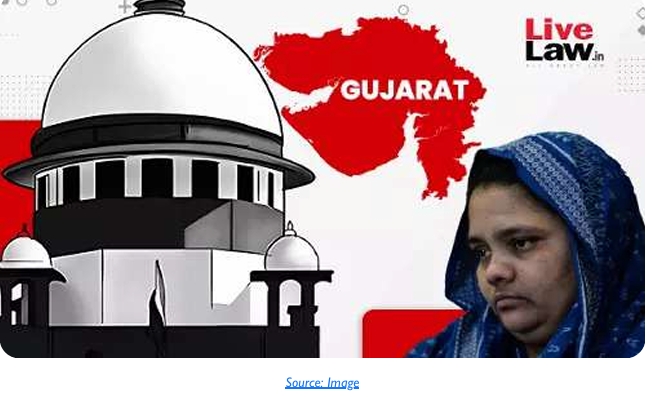
Validity of the Electoral Bonds Scheme | Association of Democratic Reforms v Union of India | Five-judge bench[5]
In the lead-up to the 2024 Lok Sabha Elections, a five-judge bench quashed the 2018 Electoral Bond Scheme. The EB Scheme allowed corporations, individuals and organisations to donate anonymously to political parties. On 15 February 2024, the Court unanimously held that voters had a right to be informed about the sources of party funding. The Court found that the 2018 Scheme was not foolproof, and did not fulfil the Union’s justification of wanting to protect donors from adverse actions by rival political parties. In a boost to free and fair elections, the Court ordered the immediate halt of bond sales and asked the Election Commission and the State Bank of India to publicly disclose the data they had hitherto collected on EB transactions.
Citizens, journalists and researchers scoured through the data, drawing connections between donations, on the one hand, and profitable government tenders and abrupt halting of criminal investigations, on the other. In August, however, the Court refused to set up a Special Investigation Team to probe allegations of quid pro quo, stating that the allegations were mere “assumptions”.
Bail for Delhi Chief Minister Arvind Kejriwal | Arvind Kejriwal v Directorate of Enforcement | Two-judge bench

The Arvind Kejriwal bail saga had the effect of relaxing the stringent interpretation of the bail norms in the Prevention of Money Laundering Act (PMLA), 2002. Kejriwal was arrested by the Enforcement Directorate (ED) for his alleged role in the Delhi Liquor Policy scam. He was also arrested by the Central Bureau of Investigation (CBI) on corruption charges in connection with the same scam. The Supreme Court noted that Kejriwal had suffered long periods of incarceration and that the trial in his case was unlikely to commence in the foreseeable future.
The Court’s decision seemed to open the doors for the release of other incarcerated Opposition political leaders like Manish Sisodia, K. Kavitha and V. Senthil Balaji. Many of the subsequent orders, too, referred to the delay in commencement of trial. More than once, the Court reiterated the maxim of “bail is the rule, jail is the exception” in the context of PMLA cases. These developments suggested that the Court has come a long way since Vijay Madanlal, the July 2022 case where it had upheld the onerous bail conditions under the PMLA. The Kejriwal case also opened a new aspect to determine the validity of an arrest under the PMLA, one of “need and necessity”.
Guidelines to curb illegal bulldozer demolitions | In Re: Directions in the matter of demolition of structures | Two-judge bench
Two years after homes of the Muslim individuals accused in the Jahangirpuri communal violence were bulldozed by authorities, the Court issued detailed directions to curb such demolitions nationwide. In September 2024, a bench took up the matter after a long hiatus, prompted by the bulldozing of the home of a Muslim auto-rickshaw driver. The action had been taken after his Muslim tenant’s son had stabbed a Hindu classmate.
The Supreme Court ruled that bulldozer demolitions of this nature infringed fundamental rights, such as the right to shelter, diluted the separation of powers by making the executive judge and jury and undermined the rule of law. The bench also laid down some procedural guidelines: a written notice to be served to the owner-occupier at least fifteen days ahead, keeping collectors and district magistrates in the loop about notices and ensuring personal hearings before a designated authority. It also held that the ground-level government officers would pay from their own pockets if any procedure were violated.
The decision addressed a serious case of executive overreach—more than 150,000 homes were razed and over 700,000 people, mainly Muslim, had been rendered homeless by bulldozing action in two years.
Landmark Judgements:
A review of landmark judgments indicates a four-fold classification. Two of these have to do with the citizenry of the country ensuring (i) social, economic and political justice, including equality of status and of opportunity; (ii) fundamental rights relating to life and liberty. Incidentally, all these find expression in the Preamble to the Constitution of India. Verily, in the Kesavananda Bharati case, Justice J M Shelat and Justice A N Grover had held that the Preamble to the Constitution contains the clue to the fundamentals of the Constitution. The third has to do with centre-state relations, and the last with the basic structure of the Constitution.
Social, economic and political justice
Mohd. Ahmed Khan v. Shah Bano Begum (1985): Had it not been for what followed, the judgment would have perhaps been classified under individual rights. The Supreme Court upheld the payment of maintenance and alimony to Shah Bano and hence to Muslim women by Muslim Husbands. The government of the day passed the Muslim Women (Protection of Rights on Divorce) Act 1986 which diluted this judgement and restricted the right to maintenance and alimony which was heavily criticized as a move to appease Muslims opposing the judgement. The Supreme court later through Danial Latifi v. Union of India case and Shamima Farooqui v. Shahid Khan upheld the Shah Bano judgement effectively nullifying the Muslim Women Act 1986.
Validity of sub-classification within reserved categories | State of Punjab v Davinder Singh | (2024) Seven-judge bench. In a potentially far-reaching judgement on the affirmative action jurisprudence in the country, a seven-judge bench of the Supreme Court upheld states’ power to create sub-classification within the reserved Scheduled Caste and Scheduled Tribe categories (SC/ST). In a 6:1 majority, the bench led by Chief Justice D.Y. Chandrachud overturned E.V. Chinnaiah v Union of India (2004).[6]

The majority reasoned that sub-classification was permissible to ensure “substantive equality” since different communities in the SC/ST list faced varying degrees of discrimination and inequality. The bench, however, held that any law creating sub-classification had to be based on empirical evidence and would be subject to judicial review.
According to Anup Surendranath, Professor of Law at National Law University, Delhi, “[T]he opinion by Chief Justice D.Y. Chandrachud (on behalf of himself and Justice Manoj Misra with all judges in the majority expressing agreement) wades into tricky waters on reservation jurisprudence. For most part, it provides much-needed clarity. One of the enduring legacies of this opinion will be its take on the relationship between reservations in Article 16 and ‘efficiency’ in Article 335.”[7]
In the wake of the judgement, several state governments indicated that they were keen to advance sub-classification. Haryana was the first to do so—weeks after the judgement, the Nayab Singh Saini-led BJP government approved the Haryana Scheduled Caste Commission Report, which recommended a 10 percent ‘sub-quota’ for deprived SCs in government jobs. Earlier this month, Telangana chief minister Revanth Reddy announced that the Commission constituted by his government to study sub-classification would submit its report. Reddy’s Congress government has made it clear that there would be a positive outcome for the Madiga community, which was prominent in spearheading the movement in favour of sub-classification.
Validity of Section 6A of the Citizenship Act (Assam Accord) | In re: Section 6A of Citizenship Act | (2024) Five-judge bench
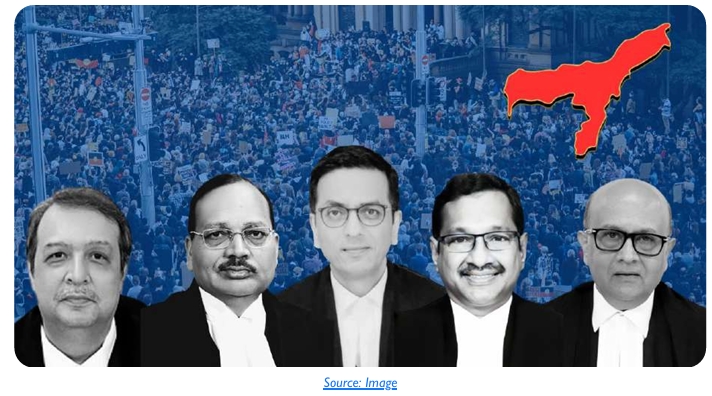
This case questioned whether Section 6A of the Citizenship Act, 1955, introduced to implement the Assam Accord of 1985, violated Articles 11, 14, 29, 326 and 355. The Accord sought to resolve the tensions caused by the influx of refugees into Assam in the wake of the Bangladesh Liberation War in 1971. It grants citizenship to those who entered before 24 March 1971, bringing legal certainty to thousands of immigrants who have lived in Assam for decades without clarity over their citizenship.
The judgement upheld Section 6A in a 4:1 majority. Rejecting claims that the provision dilutes Assamese culture and amounts to external aggression, the majority acknowledged Assam’s distinct identity and emphasised that Assam’s cultural concerns arose from non-implementation of the provision rather than the provision itself. However, the majority judgement fell short of the expectations of constituencies of native Assamese, who wished for the cut-off date for citizenship to be pushed back two more decades to 1951.
This case exemplifies a deeper tension within India’s democracy: the challenge of accommodating displaced populations while safeguarding the cultural, linguistic, and ethnic identities of regional communities. In Assam, where the interplay of migration, ethnicity and language is particularly sensitive, Section 6A remains both a product of compromise and a flashpoint for debates about identity and inclusion.[8]
Minority status of AMU | Aligarh Muslim University v Naresh Agarwal | (2024) Seven-judge bench

The Supreme Court overruled a 57-year-old precedent set by a five-judge bench in Azeez Basha v Union of India (1967). The 1967 verdict had ruled that Aligarh Muslim University (AMU) does not have a minority status under Article 30 as it was established through a Union legislation (the AMU Act of 1920). In a 4:3 majority in the present case, the Court held that institutions incorporated by a legal instrument can have a minority status if the “brain” behind the establishment of an institution was a member of the minority community; what was the purpose of the establishment; and what were the steps taken to implement this purpose (such as seeing how the land was obtained and who provided the funding).[9]
It further held that the court cannot rely on the language of the Act to determine who established the university — such as the AMU Act which states that the university was incorporated and established under the Act itself. This would make Article 30(1) — a fundamental right — subservient to a statutory enactment, the majority held.
Article 30(1) says that “all minorities, whether based on religion or language, shall have the right to establish and administer educational institutions of their choice.” In the 1967 Azeez Basha case, the SC Constitution bench had held that AMU was not a minority institution and to enjoy the status, it should have been both established and administered by the minority.
While overturning its 1967 verdict, the SC Bench also pointed out that it has “already held… that an education institution is a minority educational institution if it is established by religious or linguistic minority” and “it is not necessary to prove that administration vests with a minority to prove that it is a minority education institution because the very purpose of article 30(1) is to grant special rights on administration as a consequence of establishment. “To do otherwise, would amount to converting the consequence to a precondition,” it added. [10]
This was the first time when the Supreme Court, in 75 years, laid down such indicators. The parameters will assist a smaller bench in determining whether AMU is a minority institution or not. They are also likely to be applied in other cases where an institution seeks to control its own affairs, especially when it comes to reserving seats for students from a particular community. The present case reached the Court after AMU decided to reserve 50 percent seats in postgraduate medical courses for Muslim candidates in 2005.
Fundamental rights relating to life and liberty
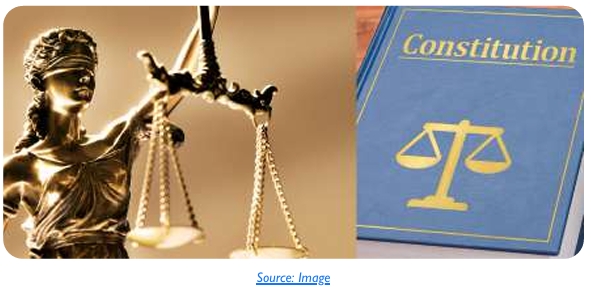
Most of landmark judgments in this category relate to Article 21 of the Constitution. Article 21 of the Indian Constitution is a cornerstone of fundamental rights. It is often regarded as the heart and soul of the Constitution because it encapsulates the quintessential right to life and personal liberty. This article is not merely a legal provision; it is a reflection of the aspirations of the founding fathers of the Indian Republic, who sought to secure the dignity and rights of every citizen. Over the years, Article 21 has evolved through numerous landmark case laws, shaping the course of Indian jurisprudence and safeguarding the fundamental rights of citizens.
Article 21 of the Indian Constitution reads, “No person shall be deprived of his life or personal liberty except according to procedure established by law.” This seemingly straightforward provision has profound implications. It guarantees two distinct but interconnected rights: the right to life and the right to personal liberty.
The right to life is not limited to mere existence; it encompasses the right to live with dignity. It includes the right to a healthy environment, the right to livelihood, and the right to protection from arbitrary or unlawful actions that may jeopardize one’s life. It is not an absolute right but can be restricted by law, provided the procedure for such restrictions is established by law and is fair, just, and reasonable.
Right to Personal Liberty: The right to personal liberty includes freedom from unlawful detention or imprisonment. It ensures that a person cannot be deprived of their freedom without due process of law. It also encompasses various aspects of personal freedom, such as freedom of movement, speech, expression, and association.
- Romesh Thappar vs State of Madras (1950): This was the first case relating to freedom of speech. The Supreme Court struck down as unconstitutional the ban on dissenting media under the Section 9 (1-A) of the Madras Maintenance of Public Order Act, 1949. This in-turn led to formulation of the 1st amendment of the Constitutionof India which clarified public order can form grounds for reasonable restrictions of free speech.
- K. Gopalan v. The State of Madras (1950). Just a day after independence, A.K. Gopalan (or AKG, as is popularly known) was arrested for stirring up the people “against His Majesty the Emperor” and charged with sedition. While he was released, just over a month later, he was detained again under the colonial laws that were still in place in the newly independent nation. After India became a republic, the Preventive Detention Act, 1950 was passed to ‘regularise’ detentions of many including AKG. “I was a political prisoner from 1930 to 1945 in the eyes of a foreign government. Under today’s popular government, I am branded as a criminal,” he wrote in his autobiography In the Cause of the People. In 1950, he moved the Supreme Court against his detention, perhaps hoping that the freedoms guaranteed by the new Constitution that came into force in 1950 would ensure his release from jail. After all, Article 21 stated that “no person shall be deprived of his life or personal liberty except according to procedure established by law”.[11]
AKG argued that the preventive detention law violated his fundamental rights under, among others, Article 21 and Article 22 of the Constitution (protection against arrest and detention). However, Article 22, while providing for “protection against arrest and detention”, including the right to be informed of charges, the right to a lawyer and the right to be produced before a court within 24 hours, carves out a strategic exception — that protection is suspended when an arrest is under a law that specifically provides for preventive detention. Thus, AK Gopalan v State of Madras would thus go on to become the first case to question the Constitution’s contrariety.
On May 19, 1950, a six-judge bench held that the preventive detention law was valid and only allowed minor procedural safeguards that the length of detention had to be informed at the time of arrest although it could be extended. While AKG lost his case, the prescient questions it raised continue to shape our rights and freedoms.
“Preventive detention is curtailing someone’s freedom based on their past conduct that was used in England and other parts during war situations. The British used it in India and while we continued it in our Constitution, Gopalan’s case brought in some procedural safeguards. Disclosure of grounds for detention, judicial review was put in place even if Gopalan lost his case in the SC. The argument that we look at our fundamental rights as a bundle and not in isolation also emerged from the arguments by Gopalan’s lawyer,” former Attorney General for India K K Venugopal told The Indian Express. His father M K Nambyar argued for AKG.
However, four of the six judges held that “procedure established by law” is a narrow threshold and a law made by Parliament, in this case the Preventive Detention Act, 1950, was sufficient to suspend the right under Article 21. The majority opinion stated that “law” had been used in the “sense of State-made law and not as an equivalent of law in the abstract or general sense embodying the principles of natural justice.”
Justice Fazl Ali penned a dissent, which Justice Mehr Chand Mahajan concurred with, saying, “The question to be decided is whether the word ‘law’ means nothing more than statute law.” He then held that the word law means “valid law” and “procedure” means “certain definite rules of proceeding and not something which is a mere pretence for procedure”.
Over two decades later, and a year after his death, AKG stood vindicated — the Supreme Court in its 1978 ruling in Maneka Gandhi v Union of India restored Justice Ali’s dissenting opinion as the Court’s majority opinion and established “due process” as a necessary criteria for any law to be constitutionally valid.
- Kharak Singh v. State of Uttar Pradesh (1963) In the Kharak Singh case, the Supreme Court adopted a wider meaning of personal liberty and said that it will include all the rights which are given under Article 19(1). The court addressed the issue of surveillance and the right to privacy. Although the court upheld the validity of surveillance laws, it recognized the right to privacy as a part of personal liberty under Article 21. This case laid the groundwork for future judgments that expanded the right to privacy as an intrinsic part of the right to life and personal liberty.
- ADM Jabalpur vs Shivkant Shukla (1976): Also known as the Habeas Corpus (ADM Jabalpur) Case. Involves a landmark judgment but for all the wrong reasons. Presided over by CJI A N Ray who had earlier given a dissenting opinion on the Kesavananda Bharati case and was appointed CJI by Mrs. Gandhi by superseding three senior brother judges, the bench by a majority of 4:1 upheld the detention of citizens during the Emergency period from 1975 to 1977. The 1976 judgment ruled that the state could suspend a person’s right to not be detained without cause.
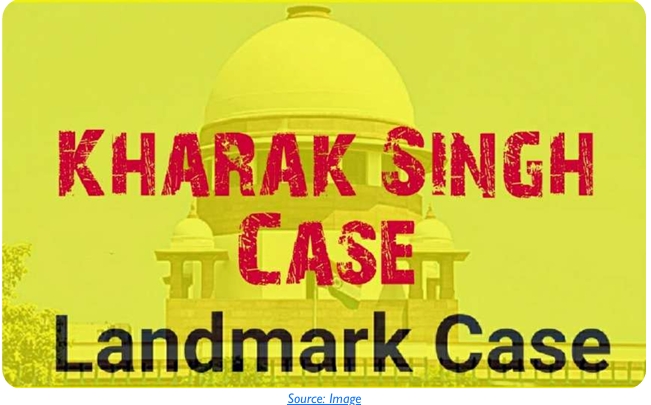
It was held that in view of the presidential order dated 27th June 1975, no writ petition can be moved in the HC under Art.226 for habeas corpus during the proclamation of emergency under Art. 359 (1). Further, the court upheld the constitutional validity of clauses 8 and 9 of Sec. 16 of the MISA, 1971.[12] Justice Y V Chandrachud (father of just retired CJI DY Chandrachud) stated that all executive action must be performed in pursuance of the law passed by the parliament. The majority also held that the court of law has no power to look into and decide the validity of a detention order under the MISA, 1971. And finally, the Basic Structure theory cannot be used to build an imaginary picture within the constitution that creates a conflict with the provisions of the constitution.
The sole dissenting judgment of Justice Khanna is classic in its simplicity and innate wisdom. For those who fight for personal liberty, the laws relating to preventive detention on detention without trial is an evil. Justice Khanna denied that Art. 21 is sole repository of right to life and personal liberty and even if Art.21 was not there in the constitution, the state has no discretion to deprive a person of his life and liberty without the authority of law. During the proclamation of emergency only the procedural power of Art. 21 is restricted but the substantive power remains intact therefore a person cannot be deprived of his right to life and personal liberty. And finally, the sanctity of life and liberty needs to be maintained in order to understand the difference between a society which is lawless and a lawful society.[13]
In 2017, in the Right to Privacy case, a nine-judge bench led by Chief Justice J.S. Khehar overturned the 1976 judgment. The judgment ruled that life and liberty are fundamental rights and that the 1976 judgment was “per incuriam”. Justice D.Y. Chandrachud, who was part of the 2017 bench, noted that the 1976 judgment (to which his father Y V Chandrachud was a part) was “seriously flawed”. He also noted that the judgment was an aberration in India’s constitutional jurisprudence.
- C. Cooper v. Union of India(1970): In this case, the Supreme Court redressed its views taken in A.K. Gopalan case. Now the court held that the word personal liberty would not only include Article 21 but also includes the 6 Fundamental Freedoms given under Article 19 (1).
- Sunil Batra v. Delhi Administration (1978). Sunil Batra’s case marked a significant development in the jurisprudence of Article 21. The court held that the right to life includes the right to live with human dignity. It declared that torture and cruel treatment in prisons violate the right to life and personal liberty. This decision led to the evolution of the concept of custodial violence and the need to protect the dignity of prisoners.
- Maneka Gandhi v. Union of India (1978). The case of Maneka Gandhi is a watershed moment in the history of Article 21. Before this case, the prevailing interpretation was that the state could deprive a person of their passport without giving reasons, as long as it was done in accordance with the procedure established by law. However, in this case, the Supreme Court held that the procedure established by law must be just, fair, and reasonable and it cannot be arbitrary, oppressive, or unreasonable. This decision expanded the scope of Article 21 by emphasizing the importance of substantive and procedural due process. In this landmark judgment, the Supreme Court held that the right to life and personal liberty under Article 21 is not limited to mere animal existence but includes the right to live with dignity.
- Olga Tellis v. Bombay Municipal Corporation (1985). In the Olga Tellis case, the Supreme Court addressed the issue of the eviction of slum dwellers in Bombay. The court held that the right to life under Article 21 includes the right to livelihood. It emphasized that eviction without providing an alternative livelihood would violate the right to life of the slum dwellers. This case laid the foundation for the recognition of the right to livelihood as an integral part of the right to life.
- Vishakha v. State of Rajasthan (1997). Vishakha’s case is a landmark judgment related to gender equality and the right to life with dignity. The Supreme Court recognized that sexual harassment at the workplace violates a woman’s fundamental rights, including her right to life and personal liberty. This case led to the formulation of guidelines known as the Vishakha Guidelines to prevent and address sexual harassment at the workplace, contributing to women’s empowerment and safety.
- Naz Foundation v. Government of NCT of Delhi (2009) The Naz Foundation case was a significant milestone in the context of LGBTQ+ rights and Article 21. The Delhi High Court, in a historic judgment, decriminalized consensual homosexual acts between adults, stating that criminalization violates the right to life and personal liberty. While the judgment was later reversed by the Supreme Court, it ignited a national conversation on LGBTQ+ rights and contributed to the eventual decriminalization of homosexuality in India.
- Selvi v. State of Karnataka (2010) The Selvi case addressed the issue of narco-analysis, brain mapping, and lie detector tests. The Supreme Court held that subjecting an individual to these tests without their consent violates the right against self-incrimination, which is a part of the right to life and personal liberty. This decision reaffirmed the importance of protecting an individual’s dignity and bodily integrity.
- Puttaswamy v. Union of India (2017) The Puttaswamy case is a landmark judgment on the right to privacy. The Supreme Court held that the right to privacy is a fundamental right under Article 21 and other related articles of the Constitution. This judgment established that the right to privacy is an intrinsic part of the right to life and personal liberty and has far-reaching implications for data protection and individual autonomy.
- Common Cause v. Union of India (2018) In the Common Cause case, the Supreme Court recognized the right to die with dignity as a facet of the right to life. The court legalized passive euthanasia and living wills, allowing individuals to make choices about their end-of-life medical treatment. This decision reflected a deep understanding of the right to life’s meaning in the context of personal autonomy and dignity.
- In National Legal Services Authority v. Union of India and Ors (2014), the Supreme Court recognised transgender as ‘third gender‘ in law and affirmed that the fundamental rightsgranted under the Constitution of India will be equally applicable to them. The court held that the gender of a person is to be decided by the person himself after looking into the Right to Life Article. So, all the rights which are given to normal people must be given to transgendered people like public toilets, medical care for transgendered persons and the provisions of reservations under Article 15 and 16 must be extended to them as they classify as a minority section.
Centre-state relations
- R. Bommai v. Union of India (1994). The Supreme Court discussed at length provisions of Article 356 of the Constitution of India(President’s Rule) and related issues. This helped put an end to the arbitrary impositions seen until then. The case established that the power under Article 356 is subject to judicial review.The case originated when the central government dismissed the Janata Dal government of S.R. Bommai in Karnataka in 1989. The dismissal was based on the claim that the government had lost its majority due to defections.[14]
While Bommai’s challenge was initially rejected by the Karnataka High Court, the Supreme Court ruled that the test of majority of the government should be done in the floor of the Assembly. The court also ruled that policies of a state government directed against the basic structure of the Constitution would be a valid ground for the exercise of the central power under Article 356.
The significance of the Bommai case is that it is one of the most quoted verdicts in the country’s political history. While all nine judges unanimously upheld the provision, the Court ruled that the President’s decision would be subject to judicial review. Bommai is still the settled law on when and how President’s rule can be imposed, and was invoked in recent cases challenging President’s rule in Uttarakhand (2016) and Arunachal Pradesh (2016), both of which were overturned by the Supreme Court.[15] Further, according to research by Alok Prasanna Kumar, Senior Resident Fellow at Vidhi Karnataka, the imposition of President’s rule drastically decreased after the Bommai verdict. Between January 1950 and March 1994, President’s Rule was imposed 100 times or an average of 2.5 times a year. Between 1995 and 2021, it has been imposed only 29 times or a little more than once a year.[16]
- Taxation of mines and minerals and regulation of industrial alcohol | Mineral Area Development Authority v Steel Authority of India; State of UP v Lalta Prasad Vaish | 2024 Nine-judge bench
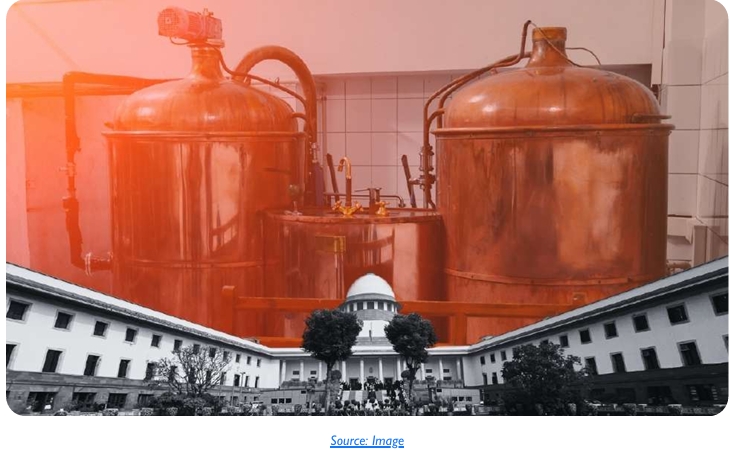
Two nine-judge benches dealt with the distribution of law-making powers between the Union and state governments this year. In Mineral Area Development Authority, an 8:1 majority held that Parliament’s power to make laws on mines and minerals cannot be extended so far that it usurps states’ powers to legislate on the subject. In Lalta Prasad Vaish, in a similar majority, the Supreme Court found that the Union’s powers under List I of the Seventh Schedule cannot be used to take away the powers that List II has vested in the states. Thus, state governments had the power to regulate industrial alcohol.
In these cases, which were seen as a shot in the arm for state autonomy, the majority found that a clear division of legislative powers between the states and the centre was critical for maintaining India’s federal structure. They stressed on the importance of interpreting the two Lists in a way that ensured that states’ law-making powers were not read narrowly.
Interestingly, Justice Nagarathna dissented and expressed similar concerns in both cases. She observed that the Union having control of critical subjects like minerals and industrial alcohol allowed the central government to take decisions that would prevent uneven economic development and discourage inter-state rivalries. “It is all important that this edifice is not dislodged while attempting to dynamically interpret the Constitution,” she wrote.
Basic structure of the Constitution
- Golaknath v State of Punjab (1967): The case involved the Golaknath family, who owned 500 acres of land in Jalandhar, Punjab. In 1953, the Punjab government passed the Punjab Security and Land Tenures Act that limited land ownership to 30 acres per person. The Golaknath family challenged the Act, arguing that it violated their fundamental rights to acquire and hold property, as guaranteed by Article 19(1)(f) (right to property)and under Article 13(3)(a), which declares that any law contravening Fundamental Rights is void. They sought judicial relief to declare the Act unconstitutional and contested the 17th Amendment, which had placed the Punjab Act in the Ninth Schedule of the Constitution, thereby rendering it immune to judicial scrutiny.
The original and unamended Article 368 was silent regarding the extent or width of the power to amend the Constitution. The government claimed unlimited power, as the Constitution had no explicit limitation.[17] Yet, while Article 368 gave Parliament the power to amend the Constitution, could any such amendment be classified as “law” if it infringed upon Article 13(3)(a) which declares that any law contravening Fundamental Rights (as enshrined in Part III of the Constitution) is void.
The Supreme Court ruled that Parliament lacked the authority to amend Fundamental Rights, introducing the doctrine of prospective overruling (that allows courts to overturn existing laws and introduce new ones, but only for future cases) reinforcing the inviolability of these rights, and establishing a foundation for the Basic Structure Doctrine in future jurisprudence.
But Parliament thought otherwise. As a result, The Constitution (Twenty-fourth Amendment) Act, 1971 came into being which amended article 368 for giving effect to the Directive Principles of State Policy and for the attainment of the objectives set out in the Preamble to the Constitution. The 1971 Act also amended article 13 of the Constitution to make it inapplicable to any amendment of the Constitution under article 368.[18] This effectively curtailed the powers of the judiciary and limited the scope of judicial review. The 25th and 29th Amendments were also passed, which sought to limit the fundamental rights of citizens and give Parliament the power to amend any part of the Constitution.
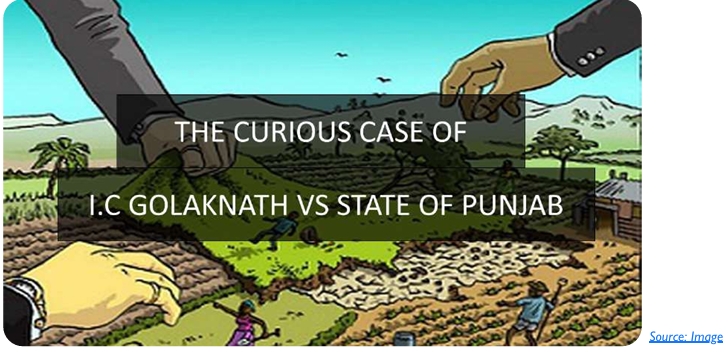
- Kesavananda Bharati v. State of Kerala (1973): Sri Kesavananda Bharati filed a petition challenging the validity of these amendments (24th, 25th and 29th), arguing that they violated the basic structure of the Constitution.[19] This led to the landmark Kesavananda Bharati judgment, which upheld the basic structure doctrine and placed limits on the power of the Parliament to amend the Constitution. The court in a 7-6 decision asserted its right to strike down amendments to the constitution that were in violation of the fundamental architecture of the constitution. JusticeHans Raj Khanna asserted through the Basic Structure doctrine that the constitution possesses a basic structure of constitutional principles and values[20]. The Court partially cemented the prior precedent Golaknath v. State of Punjab, which held that constitutional amendments through Article 368 were subject to fundamental rights review, but only if they could affect the ‘basic structure of the Constitution’. At the same time, the Court also upheld the constitutionality of the first provision of Article 31-C, which implied that laws seeking to implement the Directive Principles, which do not affect the ‘Basic Structure,’ shall not be subjected to judicial review.
The significance of the Kesavananda Bharati case lies in the fact that it established the doctrine of basic structure of the Indian Constitution. The basic structure doctrine holds that certain fundamental features of the Constitution, such as the supremacy of the Constitution, the rule of law, and the independence of the judiciary, including the power of judicial review are integral to the basic structure of the Constitution, and cannot be amended or abrogated by the Parliament through a constitutional amendment.
This doctrine has served as a check on the power of the Parliament to amend the Constitution and has ensured that the Constitution remains a living document that is responsive to changing times while preserving its fundamental values and principles. The Kesavananda Bharati case has thus had far-reaching consequences for the constitutional development of India, making it one of the most significant cases in Indian constitutional law.
End Notes:
[1] Quoted by Justice Ved Prakash, Landmark Judgments of the Supreme Court of India, PDF file
[2] Ibid
[3] Supreme Court Observer (SCO), Supreme Court Review: Top 10 judgements of 2024 https://www.scobserver.in/journal/supreme-court-review-top-10-judgements-of-2024/
[4] Ibid
[5] Ibid
[6] Supreme Court Observer (SCO), Supreme Court Review: Top 10 judgements of 2024, op. cit.
[7] “Reservations and sub-classification of SC/STs: A mixed bag for substantive equality”, Supreme Court Observer, 22 Aug 2024 https://www.scobserver.in/journal/reservations-and-sub-classification-of-sc-sts-a-mixed-bag-for-substantive-equality/#:~:text=On%201%20August%202024%2C%20in,v%20State%20of%20Andhra%20Pradesh.
[8] ibid
[9] https://indiankanoon.org/doc/33465676/
[10] https://www.scobserver.in/cases/aligarh-muslim-university-minority-status-case-background/
[11] Shaju Philip & Apurva Vishwanath, “When freedom came on Aug 15, 1947, AK Gopalan was in jail; his case a benchmark for personal liberty”, The Indian Express, February 4, 2025
[12] https://www.alec.co.in/judgement-page/the-habeas-corpus-adm-jabalpur-case
[13] https://indiankanoon.org/doc/1735815/
[14] https://indiankanoon.org/doc/60799/
[15] Apurva Vishwanath, “What was the SR Bommai judgment, which the SC relied on in its Article 370 ruling?”, The Indian Express, December 12, 2023 https://indianexpress.com/article/explained/explained-global/germany-far-right-far-left-parties-election-9842907/
[16] Ibid
[17] Shubham Verma, “Basic Structure Doctrine Explained on its Fiftieth Anniversary”, NewsClick, 24 Apr 2023 https://www.newsclick.in/basic-structure-doctrine-explained-its-fiftieth-anniversary#:~:text=In%201967%2C%20in%20the%20Golaknath,the%20Constitution%E2%80%94including%20Fundamental%20Rights.
[18] https://www.india.gov.in/my-government/constitution-india/amendments/constitution-india-twenty-fourth-amendment-act-1971#:~:text=The%20Supreme%20Court%20in%20the,III%20relating%20to%20fundamental%20rights.
[19] Google.com search
[20]https://en.wikipedia.org/wiki/Kesavananda_Bharati_v._State_of_Kerala#:~:text=(Writ%20Petition%20(Civil)%20135%20of%201970)%2C%20also,of%20the%20fundamental%20architecture%20of%20the%20constitution.

